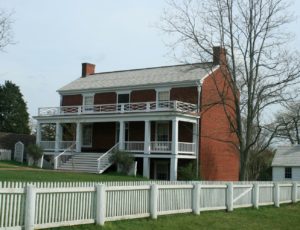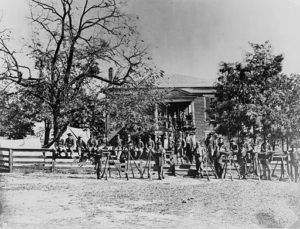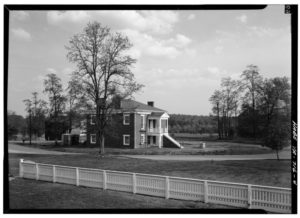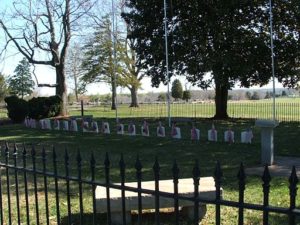Background

On April 9th, 1865, General Robert E. Lee of the Confederacy surrendered to General Ulysses S. Grant of the Union in the town of Appomattox Court House, Virginia. After the battle fought there that morning proved unsuccessful for the Confederacy, Lee conceded defeat and sat down with Grant to sign the papers ceding victory to the Union. Although this was officially the end of the war, the battle at Appomattox Court House was not the final battle of the war. Due to the slow rate at which information could be spread, many soldiers did not find out for weeks that the war was over and kept fighting as planned. The rebels of the Easter Rising likewise faced a similar communications delay.

Commemoration History
In the 1890s, there was much support for the establishment of a national park and monument at Appomattox:
“…Union and Confederate veterans in the decades following Lee’s surrender had seen Appomattox as a site of fraternal camaraderie and the immediate dissolution of sectional animosities.”
–“War over a Shrine of Peace: The Appomattox Peace Monument and Retreat from Reconciliation” by Caroline E. Janney
However, in the course of forty years, these peaceful sentiments waned, and monument enthusiasts were forced to settle for the reconstruction of the McLean House, where Lee had actually signed the papers of surrender (Janney 92). Gaining the ability to do even this was an arduous process. In the intervening years between the war and the commemoration effort, the house had been purchased by a Captain Myron E. Dunlap and completely disassembled with plans to be shipped to Chicago for the 1893 World’s Columbian Exhibition; due to personal financial difficulties, however, Dunlap’s plans fell through, and the house was left quite literally in pieces (Janney 93).

Furthermore, in 1926, a congressional committee surveyed the battlefield surrounding Appomattox Court House and did not judge it worthy of having an established military park; in 1930 a bill was finally passed allowing the erection of a peace monument, but nothing came of this, either (Janney 96). In 1933, the War Department ceded its responsibility for the potential monument to the National Parks Service, which did not want to erect a monument in the face of such strong Southern opposition (Janney 116). It was not until President Roosevelt himself approved in 1935 the construction of a park on the site–with the restoration of a McLean House as a top priority–that funding finally came through to establish the park and the blueprints for the house were located (Janney 117-118).

Significance Today
As Appomattox is the place where our nation’s bloodiest war was finally put to rest, it is still frequently visited today. Run by the National Parks Service, it features a History Trail for hiking and the reconstructed McLean House, giving it the feel of an outdoor museum. However, much like Harpers Ferry and in direct contrast to Gettysburg, it is not filled with monuments and memorials to fallen soldiers. With the exception of a small cemetery that houses a handful of Confederate graves, the focus is on the town itself, and more specifically on the house in which the Civil War finally ended. As such, it is widely held within the United States as a symbol of peace.

Connection to the Easter Rising
Much like at the GPO in Ireland, which is still used as a post office today, life in Appomattox Court House has gone on. It is, first and foremost, an ordinary town where people continue to live and work, going about their daily lives. It is a historical site that has been incorporated into ordinary life. Both the GPO and the house at Appomattox have been reconstructed to resemble the original structure as closely as possible–in the case of Appomattox, even the same blueprints were used. This is an interesting form of commemoration, because it suggests that something cannot be remembered properly unless it exists as it did in its original form. This line of thinking invalidates places that are merely interpretations or reconstructions of things that once existed because it is not possible to restore the original structure.
